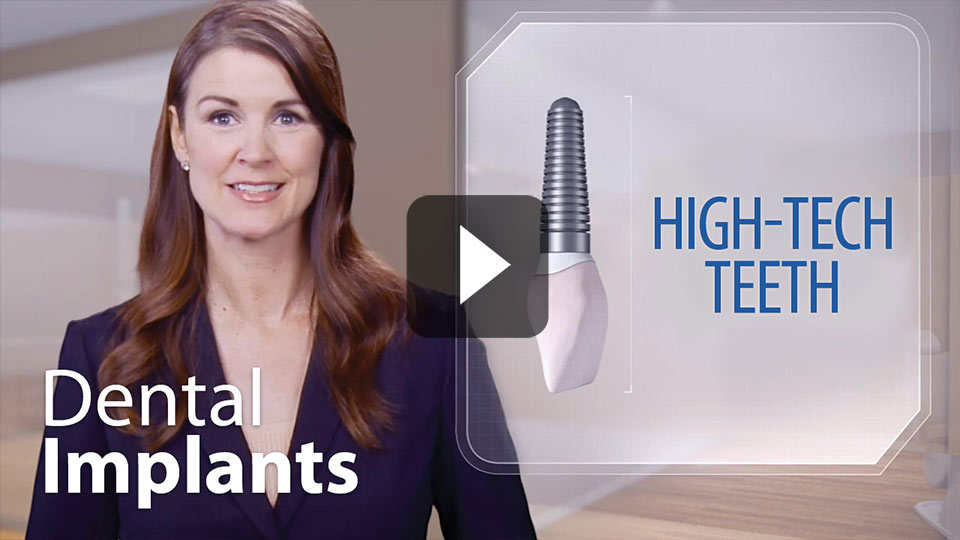Traditional and Cutting-edge
Dental Implant Retained/Supported Teeth
Dental implants offer several options for the replacement of all of a patient’s upper and/or lower teeth that improve upon the deficiencies of traditional dentures and may be more affordable than you think – allowing patients to have a new smile that functions like their natural teeth.
How it works:
Dental implants are placed into the bone onto which a traditional upper or lower denture would rest. Through the use of connecting abutments, dental implants offer a means of anchoring full upper and/or full lower false teeth. These false teeth may be removable so that the patient can remove them and clean them, or they may be permanently attached to the implants.
The benefits of dental implants:
The use of dental implants in this manner offers several advantages over traditional dentures. Traditional dentures rest only on the soft tissues of the mouth resulting in the potential for them to shift during eating and talking. This may not only result in embarrassing situations but is also detrimental to the oral tissues. Anchorage with dental implants prevents any shifting of the false teeth, which therefore preserves the oral tissues in a healthy state. Over many years of wearing a denture, the bone underneath the denture will resorb away. This will result in a denture that does not fit as well and, in severe cases, may prevent a patient from being able to wear the denture at all. The placement of dental implants in this bone and their use to anchor false teeth will inhibit this resorption of bone and will allow for many years of being able to comfortably and confidently wear false teeth. Many patients find the long borders of traditional dentures to be uncomfortable and/or have bouts of gagging related to these borders. The extension of these borders, however, is required in order to achieve stability and retention for the denture. In situations such as these, dental implants can be placed which will anchor false teeth with much more conservative and less cumbersome borders (an example would be upper false teeth in the shape of a horseshoe as opposed to a traditional denture which covers the entire roof of the mouth).
What is a dental implant?
A dental implant is an artificial tooth root that is surgically placed into the jaw bone. Over time the bone of the jaw permanently fuses to the dental implant through a process known as osseointegration, which may take several months. This allows for a tremendously stable and comfortable anchor to support your missing tooth or teeth.
Why dental implants?
Dental implants offer the ability to replace missing teeth without having to rely on other healthy teeth for anchorage. In some cases, this can actually provide a more economic alternative to traditional bridgework. Dental implants have been shown over time to have one of the highest long-term success rates of any dental procedure. When properly placed in a healthy individual, dental implants are truly the most permanent solution to missing teeth. This allows the patient to chew, speak, and smile comfortably and confidently for many years.
Single tooth replacement
A natural tooth consists of essentially two parts: root in the bone and a crown that rises above the bone and gum tissue. If this tooth is missing or becomes lost due to a cavity, fracture, periodontal disease, or another dental disease, a dental implant may be used to naturally and conservatively replace this missing tooth. The dental implant closely resembles and serves as a replacement for the natural tooth root. On top of this dental implant is placed a crown that is connected to the dental implant by way of an abutment (essentially a connecting piece). This not only preserves the teeth on either side of the missing tooth but also preserves the bone at the site of the missing tooth and offers a more natural and permanent solution when compared to traditional bridgework.
Replacement of several teeth
Similar to a situation in which a patient may be missing or lose a single tooth, several teeth in a row may be missing or become lost. In this situation, dental implants may be used to replace the natural tooth roots of two or more of these missing teeth. Bridges may then be placed on top of these dental implants by way of abutments (essentially connecting pieces). These bridges allow for several teeth to be replaced without the necessity of a dental implant for every individual missing tooth. Unlike traditional bridgework, a dental implant-supported bridge does not require the compromise of otherwise healthy teeth around the area.








